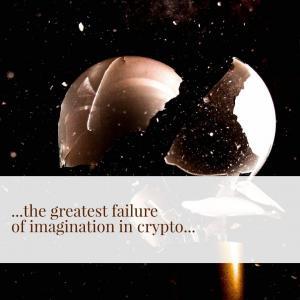Why protecting the independent mining community with ProgPoW and similar initiatives is good for decentralization and for crypto.

Viewing cryptocurrency miners as a problem to solve instead of a resource to tap is the greatest failure of imagination in the space today. It is remarkable given the ethos of decentralization and the level of passion and investment from the mining community. So how did these early-adopters become uncomfortable topics at developer project meetings and afterthoughts in the media?
Spurred on by the perfect storm of falling crypto prices, the invasion of ASICs on every “ASIC resistant” blockchain and public treatment of mining as a problem to be solved – where once optimism reigned, I now encounter a troubling complacency in my conversations with small miners. To provide a backdrop for the current state and the changing relationship between independent miners and others in the crypto community, I’ll provide a bit of history and stir in some personal perspective as a miner making a living in crypto.

Because of its current tight spot, people ask me all the time if GPU, or more broadly, non-ASIC mining is dead. My answer will always be the same – if it was possible to kill non-ASIC mining, it would already be dead. Let’s say only a handful of ASIC-resistant crypto projects remained. They would continue to attract a disproportionate share of attention solely because they’re tapping into crypto’s biggest fans and most undervalued resource – independent miners.

For as long as crypto remains an obscure industry that the mass public not only doesn’t understand but outright views with suspicion, highly engaged grassroots supporters spreading the gospel, dispelling the myths and building goodwill bit-by-bit through word of mouth are undoubtedly the best advocates. For many early adopters, mining was their introduction to the crypto space. It’s often noted that most longtime crypto supporters began as skeptics, and I’m no exception. Many years ago I published quite a few tirades about how Bitcoin was “obviously” a Ponzi scheme – but I was a PC gamer with a powerful GPU, and who can argue with free magic internet money? Especially with strong community advocacy and die-hard support. By this point in 2013, the total ASIC takeover of Bitcoin was already complete, but I couldn’t resist the allure of the Doge. It was far easier to start mining than I thought, and most importantly, I knew nearly nothing about crypto at this point. All I knew is that my GPU turned electricity into money. Once the initial excitement of watching Dogecoin trickle in wore off, mining piqued enough of my interest that I decided to find out what this crazy bitcoin thing was all about anyway. And so like many others before me, I fell into the rabbit hole.
But alas, the doge and his altcoin buddies couldn’t keep the party going forever. Eventually, it too would succumb to the brute force of ASICs, and so began the dark ages of crypto mining. Although the near complete collapse of GPU mining was merely just another victim of the bear market of 2014 – for those of you who did not live through it, let me assure you that things were even bleaker and more desperate than they are now. There was virtually nothing left to mine. Miners threw in the towel in droves and the price of GPUs on the secondary market dropped to unthinkable lows. PC gamers rejoiced, and GPU mining was all but dead. It was a time of total despair and one couldn’t be blamed for believing that mining and even crypto and bitcoin was little more than a passing fad whose time in the sun was finally at an end. Without the allure of mining, my attention turned away from crypto. And I’m sure I wasn’t alone.

It was not until well into 2015 that a ray of hope appeared on the horizon. Not only for miners but for crypto as a whole. The Ethereum whitepaper was unapologetically in favor of ASIC resistance. But its ambitions went well beyond merely just being another currency produced by the people, for the people – it was to be a full-blown computing platform. Not to mention it was the first major example of a unique new method of fundraising – the ICO. All these elements came together, and the results were magnificent. The developers were brilliant, the vision was strong, the idea was powerful and the ICO created a network of stakeholders for Ethereum and set the stage for the ICO explosion of 2017. And the most underappreciated factor in the rise of Ethereum was the unusually robust ASIC resistance that rejuvenated an army of dormant crypto fanatics. Miners finally had something to get excited about again. As the excitement spread and the code and community flourished, the value of Ethereum grew in leaps and bounds. For a time, our GPUs runneth over with the sweet nectar of ETH. And the party went on for quite some time, to the chagrin of PC gamers worldwide. XMR, ZEC, VTC, LBRY, and countless others – so much to mine, so little time.
When the crypto frenzy reached its apex in late 2017, people of all walks of life were suddenly interested in crypto. I’m sure I’m not the only crypto enthusiast who suddenly started getting all sorts of questions from friends and family that they hadn’t heard from in years. Almost overnight our obscure obsession became the talk of the world. Many of us heard the call and engaged with friends and family, explained the wonders of crypto, and even built businesses to spread the message far and wide. Time and time again, the conversation often turned very quickly to mining. Even if they couldn’t understand the blockchain, the concept of a machine that turns electricity into money was simple enough for anyone to understand. Mining was a gateway to a whole new world. The biggest challenge for crypto remains simply getting people through the door, and the resurgence of highly accessible GPU mining created a new generation of crypto enthusiasts and was, in part, responsible for the bullish market in 2017. Ethereum and other ASIC resistant chains breathed new life into cryptocurrency, bringing it into the mainstream in an attainable way for small entrepreneurs, fortifying the foundations of decentralization upon which they depend.
Of course, Bitmain and friends could never sit idly by and watch from the sidelines. One by one, previously ASIC-resistant blockchains started falling to ASICs. BTC, LTC, and Dash were already lost before this renaissance, but before long many of the smaller coins such as Decred, Sia, Pascal, and others fell quickly. Soon enough, giants started to fall. ZCash was the most high profile ASIC takeover in recent times. Cryptonight based coins such as Monero were targeted but unlike ZCash, it was soundly rejected by the majority of those communities and Cryptonight ASICs were soon little more than paperweights. Even though Ethhash had proven to be a steep hill to climb, ASIC manufacturers appear to have finally cracked that egg. Many smaller projects continue to refuse to give in and quickly switched to variants of Cryptonight and Equihash that invalidated current ASICs. I believe that decision will turn out to be a wise one in the long run.
But for many projects, particularly Ethereum – their leadership has seemingly abandoned their founding principles and turned their back on an important faction within their community. In doing so, at best they are throwing away one of their most valuable resources, and at worst they are risking the future of the project. One only has to look at Siacoin to and Bitmain’s threats to wrest control from the “corrupt founders” to see what lies at the end of that road.
Although there is a limited case to be made for ASICs increasing the security and thus the value of a blockchain, I would argue that on balance they damage the value of a blockchain by weakening the community and sucking the life and exuberance out of projects, particularly in their early stages. I believe that ASICs were a significant contributor to the severe drop in bitcoin dominance in the past few years because there was no longer an outlet for small independent miners to engage with Bitcoin. Nature abhors a vacuum, and the first project that could effectively tap into that dormant enthusiasm would reap the rewards of a highly engaged community. I believe is it far from a coincidence that the most ASIC resistant crypto in recent years quickly rose to become that the prime contender for the throne. It wasn’t the only reason, but there is no question that it was a factor that contributed to the rapid success of Ethereum.
In that light, it boggles my mind that the leaders of Ethereum are so eager to throw one of their greatest advantages away by hastily switching to Proof of Stake, let alone allowing the ASIC invasion to slowly erode enthusiasm for the project in the meantime. Even though they may be incredibly intelligent developers that are experts at finding creative technical solutions to technical problems, the factors impeding the growth and adoption of Ethereum and crypto at large are not purely or even primarily technical, but social and political. Case in point – Bitcoin vs. Bitcoin Cash. There is no question that Bitcoin struggled through severe technical difficulties during the bubble, and at least in the short term, Bitcoin Cash had a functioning technical solution. Why didn’t it easily overtake BTC then? Simple – even though BTC mining is already relatively centralized and ASIC-only, a large and vocal faction of BTC users could see the danger of traveling any further down the path to centralization that they already had. Whether that centralization was via mining, corporate power or otherwise, any form of it was anathema to their long-term vision for the project. The obvious technical solutions had tradeoffs that were not worth the sacrifice, because the long-term political and social concerns outweighed the short-term technical concerns.

Ethereum is now at a fork in the road and faces a similar prospect – but appears to be choosing to walk down the path of centralization by underestimating the threat of ASICs. I don’t believe it is because the developers and community don’t understand the theoretical threat, but simply that do not view it as a clear and present danger. The feeling in the community is clear – “who cares about ASICs anyway when Proof of Stake is coming soon and will cut off the problem at the source?“

But why are the Ethereum community and leaders so eager to transfer to Proof of Stake? The technical reasons are obvious – the ease of scaling and the energy efficiency is orders of magnitude lower. Setting aside any theoretical security concerns of PoS, what are the other tradeoffs? Unlike mining, staking is, in theory, a much easier process for non-technical users to participate in, so one could even argue that it will increase the number of participants and widen the reach of the community. Quantitatively, I agree that there are likely to be far more stakers than miners. But qualitatively, an independent miner is a much more valuable participant. Staking is a dead simple process that requires little more than a deposit. Mining is not only more complex but is competitive. It is a skill and an art, and there are dozens upon dozens of variables and decisions that every miner needs to make. These decisions can’t be made without learning a great deal about blockchains and crypto, and some of the strongest communities in the crypto space form around mining. And there is no way to out-stake everyone else, there’s no skill or art involved that engages and excites stakers – it’s little more than a boring passive investment. No one in the world is going to be so passionate about staking that they will stay up late into the night tweaking their stake if such a thing was even possible. Corporations spend billions of dollars to build communities of engaged users that build brand awareness, and small crypto miners are so engaged they’re willing to spend significant sums of money and time to directly participate in the workings of the blockchain. These are the kind of fanatics that most corporations and projects would kill for, and that pure Proof of Stake will not be able to reproduce. Why would any project be in a hurry to cast them aside?
And that’s just the social/political aspect. If you want to be totally reductionist about it, one can view miners as computers that work for the blockchain – and this is a vast and largely untapped resource. Now while I’m of the seemingly rare belief that every joule spent on Proof of Work is worth it and securing an open blockchain is the total opposite of a waste of resources – the situation as it stands is that a global computing platform is eagerly about to throw away the most powerful general-purpose computing network the world has ever seen. And yet few seem to have given much thought to giving that massive collection of GPUs something else to do. Sure, we’ve got plenty of projects like Golem, RenderToken, SOMN etc – but those are unlikely to scale in the next few years to consume the vast quantity of general-purpose computing power backing Ethereum right now. While I don’t think the substitution of “useful” work for hashing to secure the blockchain is the right course, the idea of a blockchain keeping its miners around to do some other sort of general-purpose compute within the platform at the protocol level is an idea that seems barely explored.
Even if the Ethereum protocol developers believe it to be feature creep, at the minimum they should still be able to see the wisdom of keeping those miners busy until utility token platforms have matured enough to soak up that hashing power and put it to better use at a higher layer. It seems obvious that decentralized apps are on a path where like most modern web applications, they’ll eventually be able to highly benefit from powerful compute (and storage) resources at the backend. For that reason alone, it would be wise to keep miners around for the next generation of dapps. One could argue that there’s no need to maintain a continuity between today’s miners and tomorrow’s decentralized backend compute providers. That if they build it, they will come. But if Ethereum turns their back on miners now, they risk losing all of that energy and excitement to a competitor. Ethereum came out of nowhere to nearly take the throne from Bitcoin in less than two years – and that’s approximately the amount of time projected for the PoS transition (in the best case.) Ethereum would be wise not to take their position as the leading decentralized application platform for granted, as this can change very quickly if they are not careful to hold on to every competitive advantage that they have. These are still early days, and decentralized apps are more transferable across platforms than most people realize.
Many in favor of Proof of Stake believe that the cost of securing the blockchain through PoS will ultimately raise the value of their investments because less inflation is required to pay stakers than miners. What is being missed in the greater picture is that the mining reward not only pays for security, but also for the attention and engagement of the “street team.” Whether or not you think the effect of this grassroots marketing is significant enough to justify the cost is open to debate – but right now it’s not even part of the debate. We’d never be able to know the true outcome of the path not traveled, but it is far from a certainty that reducing inflation through Proof of Stake will ultimately lead to price appreciation. It is just one variable in a massive equation, and not enough attention is being paid to potential unintended consequences.
Am I arguing against Proof of Stake then? Not really. Mostly I believe that such a massive change to the consensus of a multi-billion-dollar enterprise level blockchain is an extremely dangerous exercise that requires extraordinary amounts of caution. Mining aside, I still think it’s something that should be eased into over the course of many years. But even at the most rapid timeline, PoS is still some time away. And there’s an ASIC problem brewing right now. It’s a cancer that needs to be cut out before it spreads and overwhelms our ability to stop it. Ethereum does not want to end up like Siacoin, being held hostage by the very entities that claim to secure it.

But can we even really stop ASICs? Speaking of failures of imagination, the most pervasive argument against ASIC resistance is that there’s no such thing as a truly ASIC-proof algorithm, and therefore we should eventually capitulate and accept their total takeover of a PoW by ASICs as inevitable. Some projects take this to its logical extreme and even build ASIC friendly algorithms to invite ASICs in as soon as possible. While it is technically true that complete and total ASIC resistance is theoretically impossible – it’s also technically true that there is no such thing as a perfect antibiotic. Bacteria will always evolve to resist them. Was that a compelling argument for pharmaceutical companies to just shrug and give up on even manufacturing penicillin at the first sign of antibiotic-resistant bacteria? Of course not, that would be absurd and irresponsible. Yes, it will be a constant struggle. It will forever be a cat and mouse game – but unless all the mice roll over and give up, the cat will never catch all the mice. And they will keep evolving and multiplying.
Even right now, there is no shortage of solutions to this problem. ProgPoW is gaining some traction amongst Ethereum developers, and I am strongly in favor of implementing it alongside the issuance reduction to push back the ASIC threat for the foreseeable future. But long-term, the limiting factor in ASIC resistance will always be the willingness of developers and the community to come up with new ways to push back against ASICs. Necessity is the mother of all invention – ProgPoW is exceptionally clever, but it exists today only because the more obvious ASIC resistance solutions have already been conquered. Should there come a day when ProgPoW is failing to hold back the tide of ASICs, I think it’s selling the creativity of developers short to suggest that they’ll eventually run out of ideas.
For that reason, regardless of which path Ethereum chooses, I believe that independent mining on general purpose equipment – be it CPUs, GPUs, FPGAs or even HDDs will live on for many years to come. Now don’t get me wrong – Ethereum abandoning miners wholesale will be a massive loss to their project and to crypto in general. In the short term at least. But just as it did in 2015, projects that cultivate a strong independent mining community and find novel and clever ways to engage miners and their compute power will draw the attention of the most highly engaged users in this space. If it’s still around by then, maybe they’ll even build that project on Ethereum.

But regardless of where you see things headed in the long-term – decisions that will determine the future of Ethereum and many other projects need to be made today. Miners and Proof of Stake need not be mutually exclusive, now or in the future. Changing the Proof of Work algorithm carries risks, but the change to an alternate consensus mechanism with PoS arguably carries much greater risks. And above all, complacency while ASICs slowly erode decentralization carries existential risks for any project that chooses to ignore them. There is no longer a safe status quo to fall back on – whether we like it or not, the problem is at hand, and how we deal with it today will determine the fate of Ethereum and other projects for many years to come.
